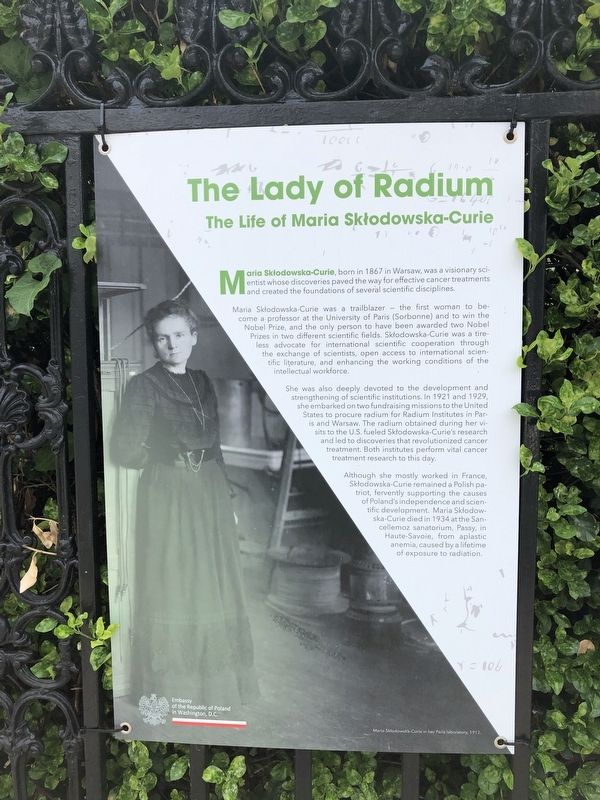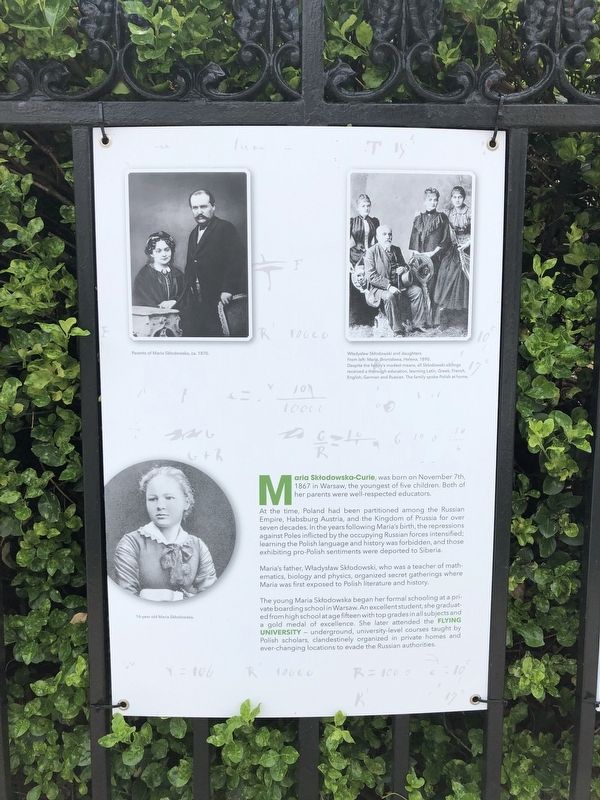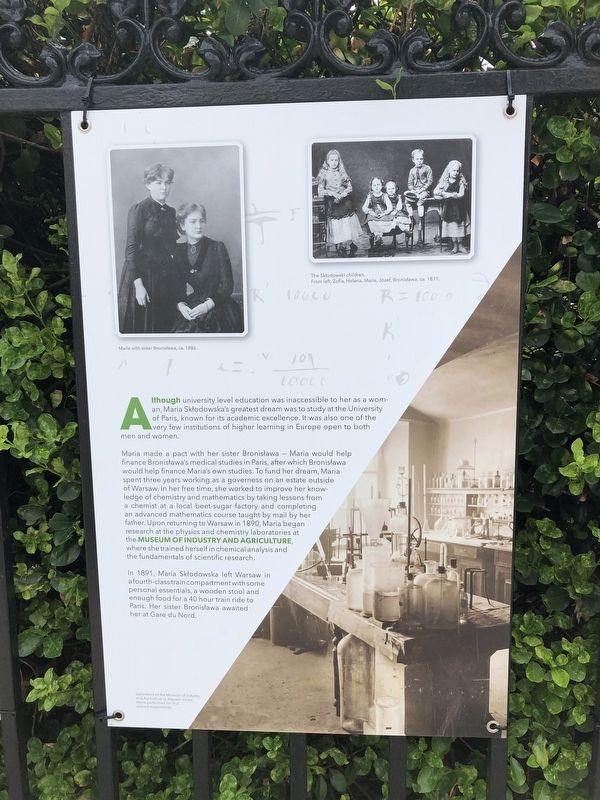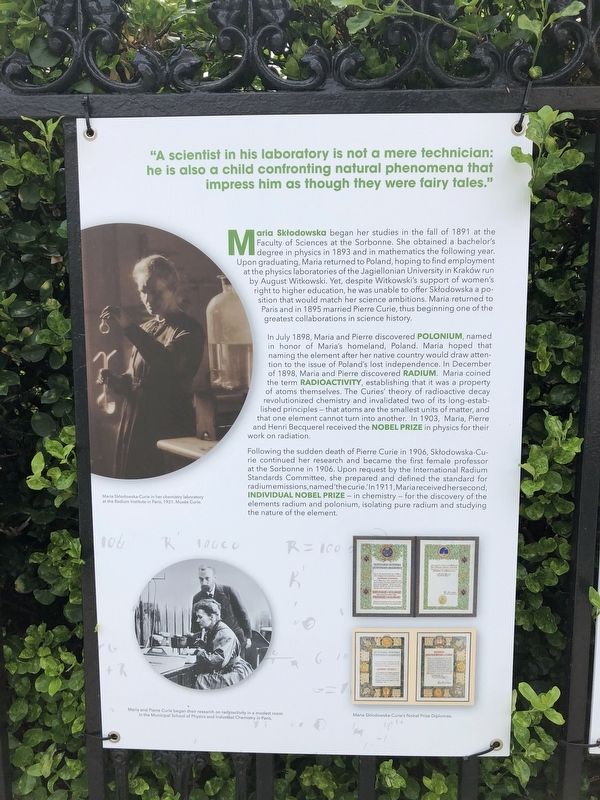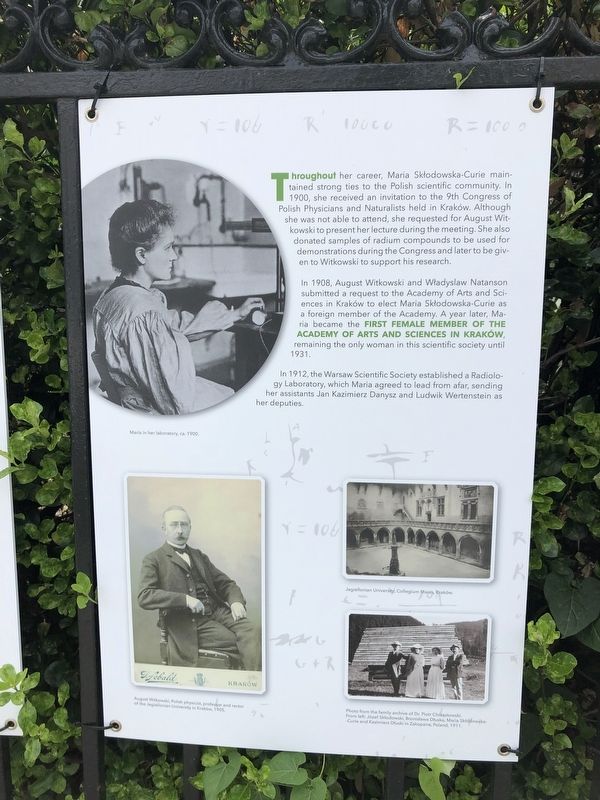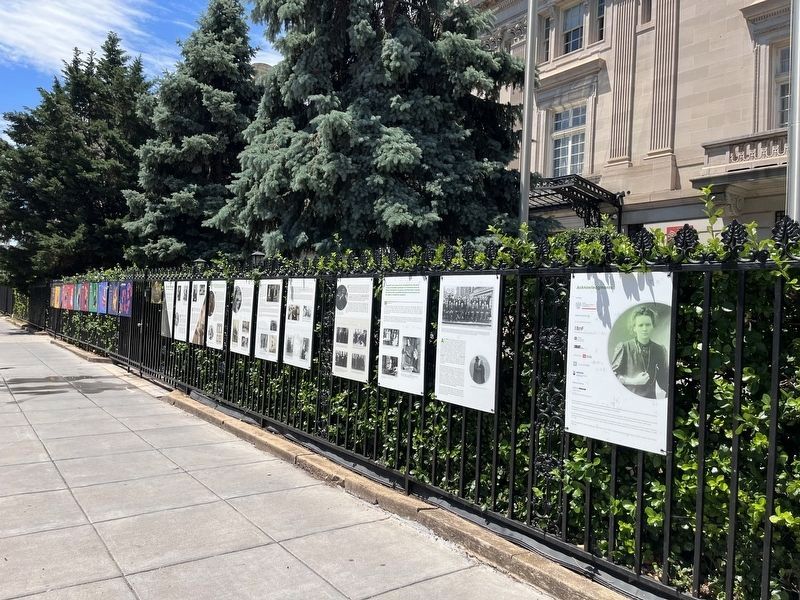Adams Morgan in Northwest Washington in Washington, District of Columbia — The American Northeast (Mid-Atlantic)
The Lady of Radium
The Life of Maria Skłodowska-Curie
Maria Skłodowska-Curie, born in 1867 in Warsaw, was a visionary scientist whose discoveries paved the way for effective cancer treatments and created the foundations of several scientific disciplines.
Maria Skłodowska-Curie was a trailblazer — the first woman to become a professor at the University of Paris (Sarbonne) and to win the Nobel Prize, and the only person to have been awarded two Nobel Prizes in two different scientific fields. Skłodowska-Curie was a tireless advocate for international scientific cooperation through the exchange of scientists, open access to international scientific literature, and enhancing the working conditions of the intellectual workforce.
She was also deeply devoted to the development and strengthening of scientific institutions. In 1921 and 1929, she embarked on two fundraising missions to the United States to procure radium in Radium Institutes in Paris and Warsaw. The radium obtained her visits to the U.S. fueled Skłodowska-Curie's research and led to discoveries that revolutionized cancer treatment. Both institutes perform vital cancer treatment research to this day.
Although she mostly worked in France, Skłodowska-Curie remained a Polish patriot, fervently supporting the causes of Poland's independence and scientific development. Marie Skłodowska-Curie died in 1934 at the Sancellemoz sanatorium, Passy, in Haute-Savoie, from aplastic anemia, caused by a lifetime of exposure to radiation.
Maria Skłodowska-Curie, was born on November 7th, 1867 in Warsaw, the youngest of five children. Both of her parents were well-respected educators.
At the time, Poland had been partitioned among the Russian Empire, Habsburg Austria, and the Kingdom of Prussia for over seven decades. In the years following Maria's birth, the repressions against Poles inflicted by the occupying Russian forces intensified; learning the Polish language and history was forbidden, and those exhibiting pro-Polish sentiments were deported to Siberia.
Maria's father, Władysław Skłodowska, who was a teacher of mathematics, biology and physics, organized secret gatherings where Maria was first exposed to Polish literature and history.
The young Maria Skłodowska began her formal schooling at a private boarding school in Warsaw. An excellent student, she graduated from high school at age fifteen with top grades in all subjects and a gold medal of excellence. She later attended the Flying University — underground, university-level courses taught by Polish scholars, clandestinely organized in private homes and ever-changing locations to evade the Russian authorities.
Although
Maria made a pact with her sister Bronisława — Maria would help finance Bronisława's medical studies in Paris, after which Bronisława would help finance Maria's own studies. To fund her dream, Maria spent three years working as a governess on an estate outside of warsaw. In her free time, she worked to improve her knowledge of chemistry and mathematic by taking lessons from a chemist at a local beet-sugar factory and completing an advanced mathematics course taught by mail by her father. Upon returning to Warsaw in 1890, Maria began research at the physics and chemistry laboratories at the Museum of Industry and Agriculture, where she trained herself in chemical analysis and the fundamentals of scientific research.
In 1891, Maria Skłodowska left Warsaw in a fourth-class train compartment with some personal essentials, a wooden stool and enough food for a 40 hour train ride to Paris. Her sister Bronisława awaited her at Gare du Nord.
"A scientist in his laboratory is not a mere technician: he is also a child confronting naturalphenomena that impress him as though they were fairy tales."
Maria Skłodowska began her studies in the fall of 1891 at the Faculty of Sciences at the Sorbonne. She obtained a bachelor's degree in physics in 1893 and in mathematics the following year. Upon graduating, Maria returned to Poland, hoping to find employment at the physics laboratories of the Jagiellonian University in Kraków run by August Witkowski. Yet, despite Witkowski's support of women's right to higher education, he was unable to offer Skłodowska a position that would match her scientific ambitions. Maria returned to Paris and in 1895 married Pierre Curie, thus beginning one of the greatest collaborations in scientific history.
In July 1898, Maria and Pierre discovered Polonium, named in honor of Maria's homeland Poland. Maria hoped that naming the element after her native country would draw attention to the issue of Poland's lost independence. In December of 1898, Maria and Pierre discovered Radium. Maria coined the term radioactivity, establishing that it was a property of the atoms themselves. The Curies' theory of radioactive decay revolutionized chemistry and invalidated two of its long-established principles — that atoms are the smallest units of matter, and that one element cannot turn into another. In 1903, Maria, Pierre, and Henri
Following the sudden death of Pierre Curie in 1906, Skłodowska-Curie continued her research and became the first female professor at the Sorbonne in 1906. Upon request by the International Radium Standards Committee, she prepared and defined the standard or radium emissions, named 'the curie.' In 1911, Maria received her second, individual Nobel Prize — in chemistry — for the discovery of the elements radium and polonium, isolating pure radium and studying the nature of the elements.
Throughout her career, Maria Skłodowska-Curie maintained strong ties to the Polish scientific community. In 1900, she received an invitation to the 9th Congress of Polish Physicians and Naturalists held in Kraków. Although she was not able to attend, she requested for August Witkowski to present her lecture during the meeting. She also donated samples of radium compounds to be used for demonstrations during the Congress and later to be given to Witkowski to support his research.
In 1908, August Witkowski and Władyslaw Natonson submitted a request to the Academy of Arts and Sciences in Kraków to elect Maria Skłodowska-Curie as a foreign member of the Academy. A year later, Maria became the first female member of the Academy of Arts and Sciences in Kraków,
In 1912, the Warsaw Scientific Society established a Radiology Laboratory, which Maria agreed to lead from afar, sending her assistants Jan Kazimierz Danysz and Ludwik Wertenstein as her deputies.
Maria Skłodowska-Curie never patented her discovery of radium or its medical applications. On the contrary, she freely shared information about the extraction process and the allocation of radium for use in medical treatments. At the time of the discovery, however, the price of one gram of radium was prohibitive, at USD 100,000 (USD 1.3 million in today's dollars), and Maria did not have the means to secure it.
In 1920, an American journalist and editor, Mrs. Marie Mattingly Meloney, was granted an interview with Maria Skłodowska-Curie at Maria's Parisian laboratory. During the interview, Skłodowska-Curie shared that her dream was to obtain a gram of radium to continue her research. Inspired by the scientist's trailblazing work, Mrs. Meloney launched a successful fundraising campaign among American women to support Skłodowska-Curie's research.
In May 1921, Skłodowska-Curie embarked on her first journey to the United States. The tour began with visits to women's colleges, including Smith College, Mt. Holyoke and Vassar
During her trip to the United States, Skłodowska-Curie received several honorary doctorates and awards including membership in the American Philosophical Society and a medal of Willard Gibbs from the American Chemical Society.
The American people helped fuel Maria Skłodowska-Curie's vital research twice. Following the arrangements of Mrs. Meloney, Maria Skłodowska-Curie received the gift of radium in Washington, D.C. directly from U.S. President Warren Harding on May 20th, 1921. Maria Skłodowska arrived at the White House to receive a deed of donation and a small key to a box containing the gram of radium from President Harding himself.
After Poland regained independence in 1918, Maria Skłodowska-Curie asked Mrs. Meloney if the American people could help raise funds for another gram of radium for a radium institute in Maria's homeland, reborn in the aftermath of WWI. The second fundraising effort also proved successful and on October 30, 1929, President Herbert Hoover presented Maria with a $50,000 bank note to purchase a gram of radium for Poland.
In 1923, a group of Polish physicians formed the Polish Committee for Cancer Control and established the first Polish Program Against Cancer. Maria's sister, Bronisława Dłuska, spearheaded a fundraising campaign—the Maria Skłodowska-Curie National Donation to Build the Radium Institute. Bronisława Dłuska, who was a doctor herself, later became the first director of the newly founded Radium Institute.
In 1925, during a meeting of the Warsaw Scientific Society, Maria laid out plans for the organization of the Radium Institute in Warsaw; she hoped that it would become a national center focusing on both cancer therapy and research. In the same year, she replaced the cornerstone of the new Institute in Warsaw.
Skłodowska-Curie personally supervised the construction of the Radium Institute. During the opening ceremony on May 29, 1932, she presented the gram of radium funded by the American people. The institution is known today as the Maria Skłodowska-Curie National Research Institute of Oncology. In accordance with Maria Skłodowska-Curie's wishes, it continues to be a thriving research center and hospital, specializing in diagnostics, therapies and rehabilitation for cancer patients.
"Scientific work must not be considered from the point of view of the direct usefulness of it. It must be done for itself, for the beauty of science, and then there is always a chance that a scientific study may become like the radium, a benefit for mankind."
Maria Skłodowska-Curie's discoveries led to the development of several fields of modern science and medicine.
The discovery of polonium and radium laid the basis for a new science of radioactivity, aiding the discovery of further radioactive elements. The method of extraction of these chemical elements continues to be in use today. Maria and Pierre's discovery that radiation from the radioactive substances causes chemical reactions marked the birth of radiation chemistry. Their theories challenged the indivisible nature of the atom and led to the development of nuclear physics and the harnessing of nuclear power.
Skłodowska-Curie's discoveries proved to have key applications in medicine. During WWI, Maria served as the director of the Red Cross Radiology Service and created mobile radiological laboratories known as the "petites curies." In this way, she helped popularize the use of x-rays for the diagnosis and treatment of disease outside of a hospital setting, transforming field medicine.
After WWI, Maria Skłodowska-Curie became the director of the physics and chemistry laboratory at the Radium Institute in Paris. The Institute consisted of two laboratories, the Pasteur laboratory for biological research, directed by Claudius Regaud, and the Curie laboratory for physics and chemistry research, directed by Maria Skłodowska-Curie. The Institute worked on medical applications of radioactivity, paving the way for the use of radiation therapy in cancer treatment. Radium therapy came to be known as Telecurie Therapy in France and involved placing small vials of radium around the tumor site. Skłodowska-Curie's research in radiation therapy and diagnostic radiological imaging laid the foundations for modern day medical physics.
Maria Skłodowska-Curie was an avid advocate for international scientific cooperation, open access to an international scientific bibliography, and standardization of international scientific scholarship. She used her position in the League of Nation's International Committee on Intellectual Cooperation, a predecessor of UNESCO, to advocate for the development of scientific institutions, including in Poland. She fostered international scientific exchange by hosting many foreign researchers in her laboratory in Paris, always ensuring that Polish scientists were well-represented.
The story of Maria Skłodowska-Curie is one of intellectual curiosity and perseverance. She declared that it would be opposed to the scientific spirit to profit from her discoveries, leaving a legacy of inspiration for generations of scientists. Skłodowska-Curie Bronisława
Erected 2021 by Embassy of the Republic of Poland in Washington, D.C.
Topics and series. This historical marker is listed in these topic lists: Education • Patriots & Patriotism • Science & Medicine • Women. In addition, it is included in the Former U.S. Presidents: #29 Warren G. Harding, and the Former U.S. Presidents: #31 Herbert Hoover series lists. A significant historical year for this entry is 1867.
Location. 38° 55.464′ N, 77° 2.2′ W. Marker is in Northwest Washington in Washington, District of Columbia. It is in Adams Morgan. Marker is on 16th Street Northwest just south of Fuller Street Northwest, on the right when traveling south. Touch for map. Marker is at or near this postal address: 2640 16th St NW, Washington DC 20009, United States of America. Touch for directions.
Other nearby markers. At least 8 other markers are within walking distance of this marker. Polish Suffragists (a few steps from this marker); Irena Sendler (a few steps from this marker); Maria Siemionow (a few steps from this marker); Anna Walentynowicz (a few steps from this marker); Maria Skłodowska-Curie (a few steps from this marker); Olga Boznańska (a few steps from this marker); Krystyna Chojnowska-Liskiewicz (a few steps from this marker); Olga Tokarczuk (a few steps from this marker). Touch for a list and map of all markers in Northwest Washington.
Credits. This page was last revised on January 30, 2023. It was originally submitted on June 12, 2021, by Devry Becker Jones of Washington, District of Columbia. This page has been viewed 182 times since then and 15 times this year. Photos: 1, 2, 3, 4, 5. submitted on June 12, 2021, by Devry Becker Jones of Washington, District of Columbia. 6. submitted on June 20, 2022, by Devry Becker Jones of Washington, District of Columbia.
